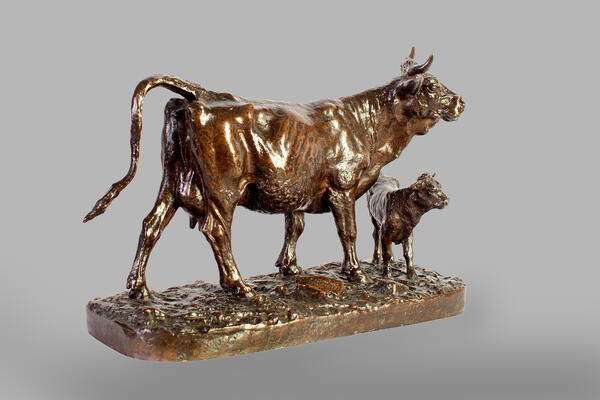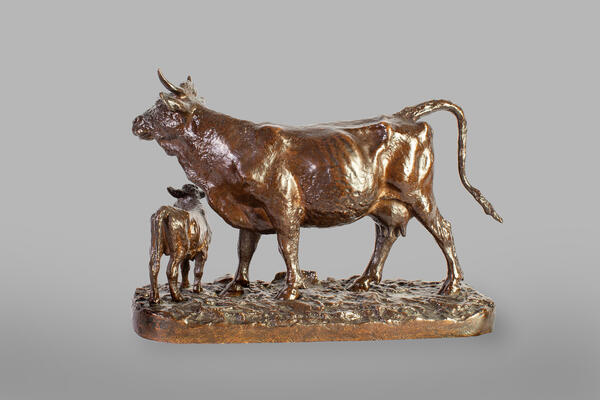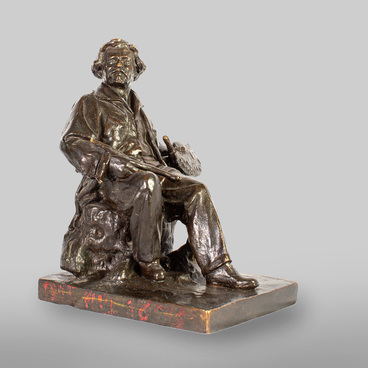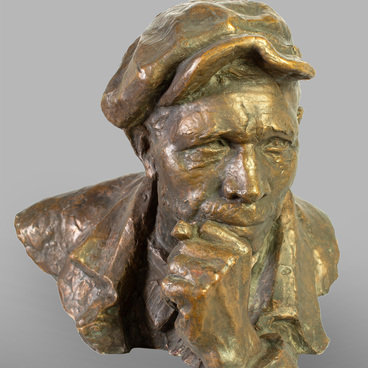The group of sculptures called “Cow and Calf”, housed in the Tambov Art Gallery, is an excellent example of the animalier genre, which was widely popular in French sculpture of the 19th century. The work was created by the French sculptor Christophe Fratin (1801–1864).
Christophe Fratin was born in the city of Metz in northeast France. The sculptor’s father, a professional taxidermist, that is, a person who creates stuffed animals, instilled an interest in the world of animals in his son. Fratin received his art education in Paris in the studio of the famous romantic painter and sculptor Théodore Géricault. The young sculptor Fratin first exhibited at the Paris Salon in 1831, when he, together with other soon-to-be-famous sculptors Antoine-Louis Barye and Alexandre Jouannet, presented sculptural images of animals. Fratin’s brilliantly executed figurines of thoroughbred English stallions, inspired by Géricault’s famous series of graphic art, received well-deserved critical acclaim from experts and the public.
From 1831 to 1842, as well as between 1850 and 1862, the sculptor was a constant participant in the Salon exhibitions, displaying animal figurines made from bronze and terracotta. Fratin gained worldwide fame after participating in the Great Exhibition in London in 1851, where his works were very popular with the British and Americans.
The talented sculptor created not only chamber, but also monumental animalier compositions that adorned the Botanical Garden of Metz, the Sanssouci Park in Potsdam, and the Montrouge Square in Paris. Fratin’s works are housed in some of the largest museums in Europe and America.
Christophe Fratin shared the realistic approach the Barbizon painters had toward nature and worked on simple everyday subjects, revealing the hidden poetry of the world. This composition fascinates with the way the relationship of the animals is humanized, conveying the expression of such sentiments as maternal tenderness and affection. The works of Christoph Fratin were quite famous in Russia as well.
Christophe Fratin was born in the city of Metz in northeast France. The sculptor’s father, a professional taxidermist, that is, a person who creates stuffed animals, instilled an interest in the world of animals in his son. Fratin received his art education in Paris in the studio of the famous romantic painter and sculptor Théodore Géricault. The young sculptor Fratin first exhibited at the Paris Salon in 1831, when he, together with other soon-to-be-famous sculptors Antoine-Louis Barye and Alexandre Jouannet, presented sculptural images of animals. Fratin’s brilliantly executed figurines of thoroughbred English stallions, inspired by Géricault’s famous series of graphic art, received well-deserved critical acclaim from experts and the public.
From 1831 to 1842, as well as between 1850 and 1862, the sculptor was a constant participant in the Salon exhibitions, displaying animal figurines made from bronze and terracotta. Fratin gained worldwide fame after participating in the Great Exhibition in London in 1851, where his works were very popular with the British and Americans.
The talented sculptor created not only chamber, but also monumental animalier compositions that adorned the Botanical Garden of Metz, the Sanssouci Park in Potsdam, and the Montrouge Square in Paris. Fratin’s works are housed in some of the largest museums in Europe and America.
Christophe Fratin shared the realistic approach the Barbizon painters had toward nature and worked on simple everyday subjects, revealing the hidden poetry of the world. This composition fascinates with the way the relationship of the animals is humanized, conveying the expression of such sentiments as maternal tenderness and affection. The works of Christoph Fratin were quite famous in Russia as well.






